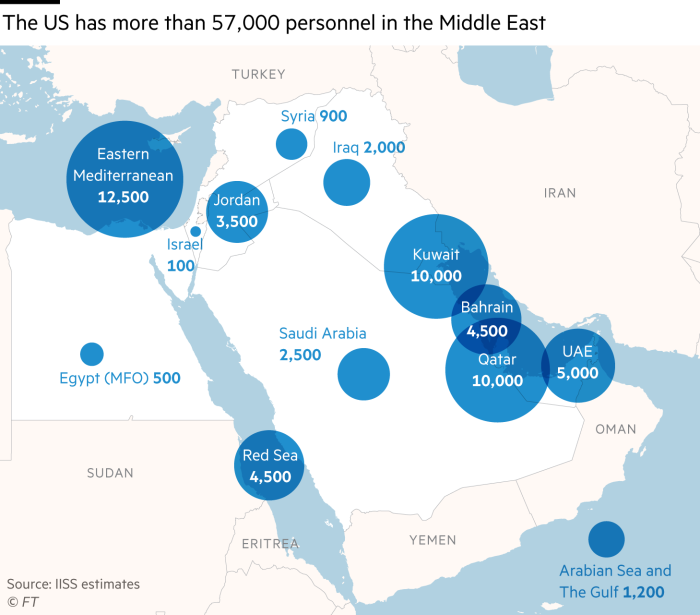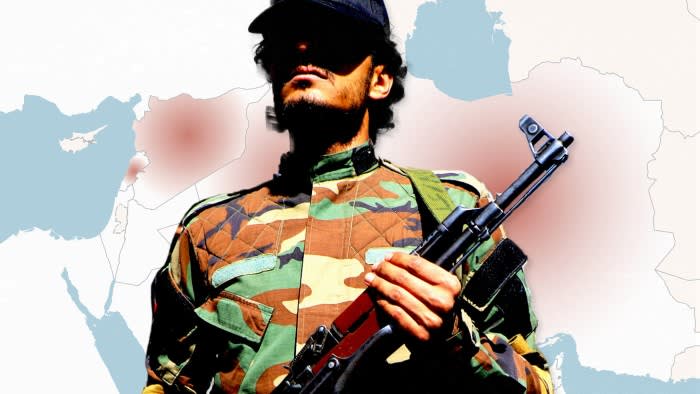It took just a day after Hamas’s devastating attack on Israel for the US to deliver a muscular display of military support for the Jewish state — and a message of warning to its regional foes.
In what US defence secretary Lloyd Austin described as steps to “bolster regional deterrence efforts”, Washington announced it was dispatching a carrier strike group to the eastern Mediterranean and augmenting its fighter jet squadrons across the region.
It was the first sign that US President Joe Biden’s administration was concerned that the scale of Hamas’s October 7 attack on Israel, and the ferocity of its retaliatory offensive on Hamas-run Gaza, had heightened the risk of a broader conflict, which, in a worst-case scenario, could draw US forces into combat.
Since then, the US has deployed another carrier strike group to the Gulf, along with air defence systems, a nuclear-powered submarine and more than 3,000 additional troops, as it seeks to bolster the protection of American forces in the region and to deter Iran and the militant groups it supports, which include Hamas.
On Sunday, the US launched its third strike in as many weeks against Iranian-backed militants in Syria, in what appeared to be an escalation by Washington as it retaliates to dozens of attacks on American forces in the region.
Hizbollah threat
Washington’s prime worry is that as Israel besieges and bombards Hamas-controlled Gaza, there is the risk of a second front opening up on Israel’s northern border involving Hizbollah, the powerful Iranian-backed Lebanese militant group.
Hizbollah fought a 34-day war with Israel in 2006 and is estimated to have 20,000 to 50,000 fighters and an arsenal of attack drones, small arms, artillery, tanks and increasingly sophisticated precision-guided missiles. There are also Palestinian militants in Lebanon.
Israeli forces and Hizbollah — as well as Palestinian militants in Lebanon — have exchanged almost daily cross-border fire since October 7. The clashes have steadily escalated, but so far have stopped short of a full-blown conflict. The fear, however, is that a mistake or miscalculation by either side takes it to a new level.
Hizbollah’s leader Hassan Nasrallah on Saturday warned that it had “upgraded” its attacks by using new weapons and had diversified its targets inside Israel. “This front will remain active,” Nasrallah said in his second televised address since Israel declared war on Hamas.
The Lebanese movement is only one of multiple threats posed to Israel and US troops by regional militant groups armed and supported by Iran — the so-called Axis of Resistance.

Iraqi militias
Another significant US concern is the escalation of attacks on its troops and personnel from militias in Iraq. There are 2,000 to 2,500 American soldiers based in Iraq who train Iraqi forces and assist in the fight against the jihadist group Isis.
A shadowy group known as the “Islamic Resistance of Iraq” has already claimed more than 50 attacks against US forces in Iraq and Syria — where another 900 troops are deployed as part of the fight against Isis — since October 17. The group has also claimed it had launched strikes against the city of Eilat in southern Israel.
Analysts believe the “Islamic Resistance of Iraq” is a front for Iranian-backed factions within an umbrella of militias known as Hashd al-Shaabi. These have become powerful military and political forces, boast tens of thousands of fighters and are also integrated into the state.
Many of the Shia militias’ leaders have historical links to the Islamic republic, having lived and trained in Iran when Saddam Hussein, a Sunni, ruled Iraq. They returned to Iraq after the 2003 US-led invasion, where they fought against US-led coalition forces and became embroiled in sectarian violence after Saddam’s ouster.
Their political and military influence in Iraq rose significantly after they played a role in countering Isis’s blitz across the country in 2014.
The more extreme factions have a history of targeting American bases and personnel in Iraq whenever there is a flare-up of tension between the US and Iran, notably during Donald Trump’s presidency after he withdrew in 2018 from the 2015 nuclear deal that Tehran signed with world powers and imposed a wave of sanctions on the republic.
Militant groups in Syria
There are also numerous Iranian-backed militias in Syria, where Iran intervened militarily to back President Bashar al-Assad after a popular 2011 uprising against his regime morphed into a civil war.
Rather than deploying large numbers of its own forces in Syria, Tehran mobilised and sent Shia militant groups, including Lebanon’s Hizbollah, and Syrian and foreign militias to fight alongside Assad regime troops.
In doing so, they set up bases in southern Syria, creating another front to target Israel and the occupied Golan Heights. Since the war between Israel and Hamas broke out, several rockets and mortars have been fired into the Golan Heights.
Houthi rebels in Yemen
Further afield, Houthi rebels, which control northern Yemen, have also sought to strike Israel. The Houthis claim to have launched at least three drone and missile attacks against Israel since October 7. The US and the Israeli military said they had intercepted projectiles in the Red Sea area fired from Yemen.
The Houthis also shot down an unmanned US drone off Yemen’s coast this month.
The battle-hardened Houthis have been fighting in a more than eight-year war against a Saudi-led coalition that intervened in the conflict to support Yemen’s ousted government.
Since 2015, the rebels have launched hundreds of missile and drone attacks into Saudi Arabia. Last year they also struck Abu Dhabi, the United Arab Emirates’ capital.
The Houthis, members of the Zaydi sect of Shia Islam, are less ideologically aligned to Iran than some of the other regional militant groups. But the US and Gulf states accuse Tehran of supplying the Houthis with missile and drone technology, as well as training.
Iran’s own forces
In Iran itself, the 120,000-strong elite Revolutionary Guards is the main threat to Israeli and western targets. Its wing responsible for foreign operations, the powerful Quds force, also co-ordinates and trains Tehran’s regional proxies.
As Trump mounted his “maximum pressure” policy against the republic, the US blamed Iran for sabotaging tankers in the Gulf and for a sophisticated missile and drone attack on Saudi Arabia’s oil infrastructure in September 2019, which temporarily knocked out half the kingdom’s crude output. The guards also shot down a US spy drone that year.
During that period of heightened tensions, Iranian hardliners often threatened to disrupt shipping through the Strait of Hormuz, one of the world’s busiest maritime trade routes, through which a third of all seaborne oil cargoes pass each day. However, western diplomats believe Tehran’s calculus is to stay on the sidelines of the Israel-Hamas conflict.
US presence in the region
The 3,200 extra troops that the US has sent to the region in the past month include air defence operators, a marine crisis response force and those with expertise in explosive ordnance disposal, military officials said.
It has also sent air-defence systems such as its state-of-the art Terminal High Altitude Area Defense (THAAD) system and Patriot batteries.
The deployments add to the muscular military presence the US already retained across the Middle East to combat the myriad threats and support its regional allies.
Its largest base in the region is Al Udeid in Qatar, but the US has troops deployed across the Middle East, including in the UAE, Kuwait, Saudi Arabia and Bahrain, which is home to the US Navy’s Fifth Fleet.
The number of American troops in the region has ebbed and flowed since the 2003 invasion of Iraq. US troop levels in Iraq peaked at 170,000 in 2007 before Washington eventually withdrew all combat troops at the end of 2011.
After the 2011 withdrawal from Iraq, the number of US troops in the Middle East is estimated to have been between 40,000 and 50,000. Some 2,000 US troops were sent back to Iraq in 2014 to help battle Isis.
Trump then ramped up the US’s military footprint in the region between 2019 and 2020, as tensions with Iran pushed the two foes to the brink of war. During the Trump administration, troop levels peaked between 60,000 and 70,000.

When Biden took office, he sought to de-escalate tensions in the region. He oversaw the chaotic US withdrawal from Afghanistan in 2021. The same year, the Pentagon pulled some of its air defences from Saudi Arabia for what it called maintenance and rotation purposes.
More than 20 Patriot batteries remained in the kingdom and the US continues to have more than 57,000 troops in the Middle East, according to estimates from the International Institute for Strategic Studies.
But the pullout from Afghanistan and the decision to rotate out the Patriots worsened the perception in the Arab world that successive US administrations had been disengaging from the region.
Now the Israel-Hamas war, and the alarm bells it is ringing, has forced the US to beef up its military assets once more.
Additional reporting by Raya Jalabi in Beirut. Cartography by Ian Bott, Cleve Jones and Steven Bernard in London

